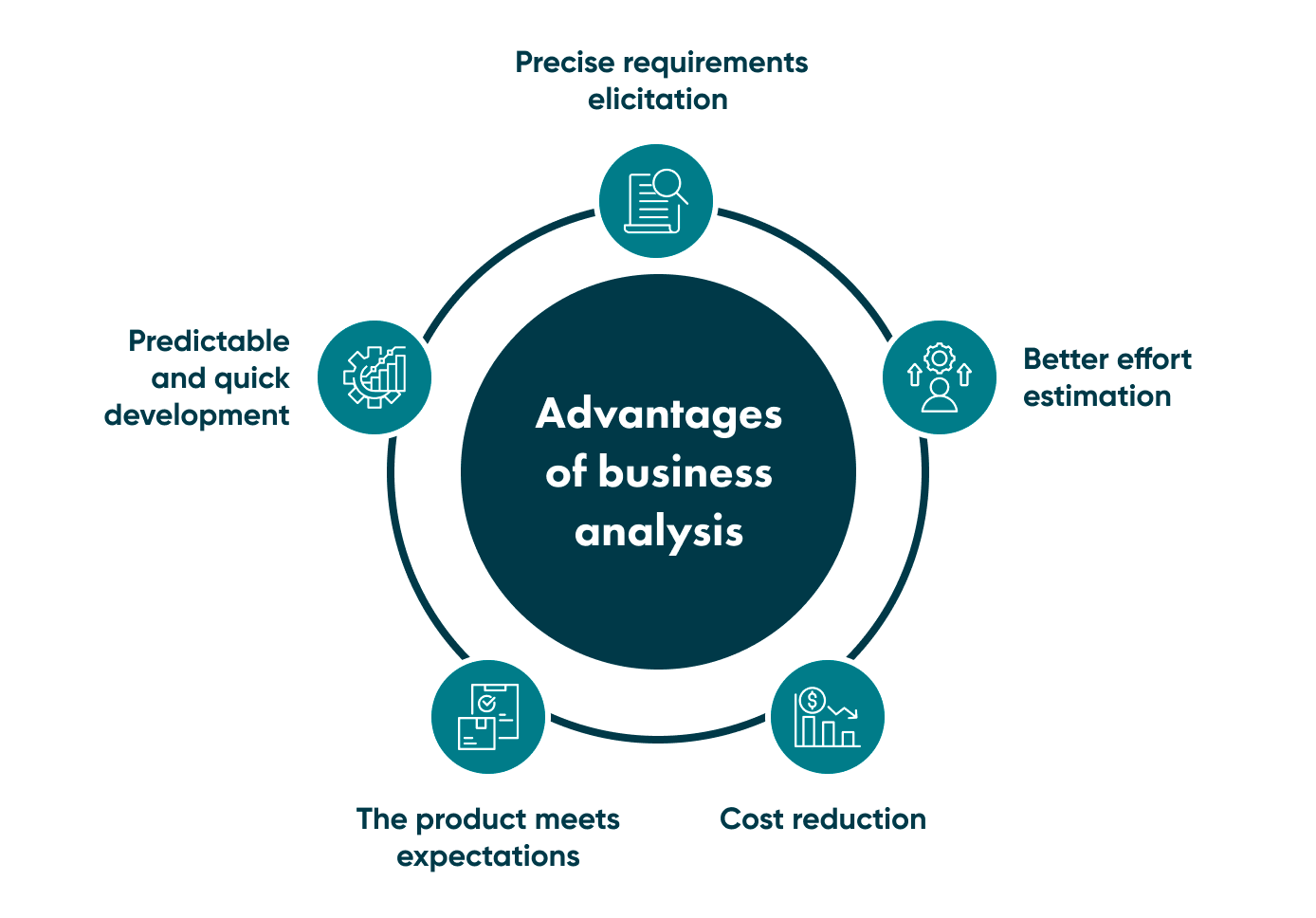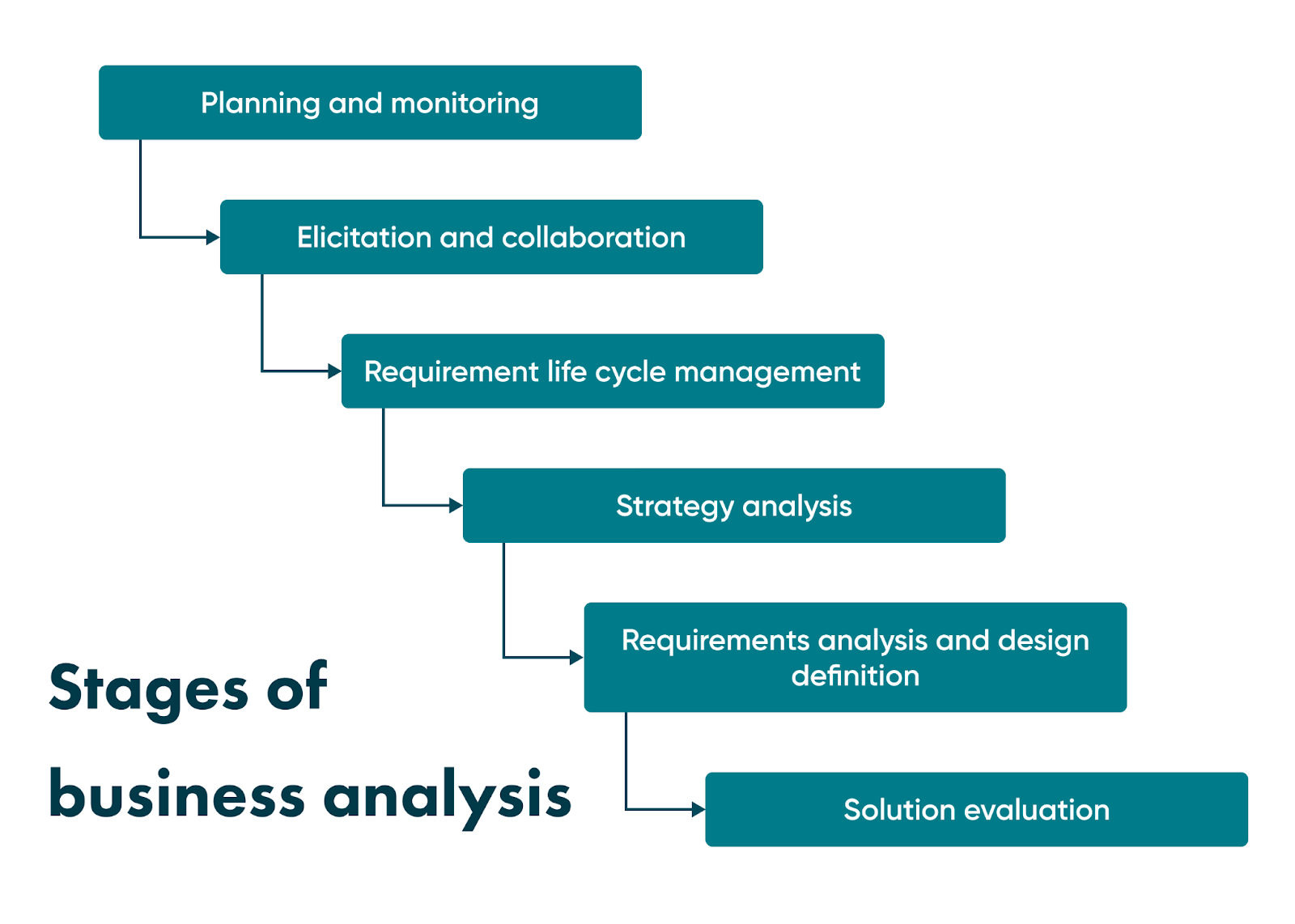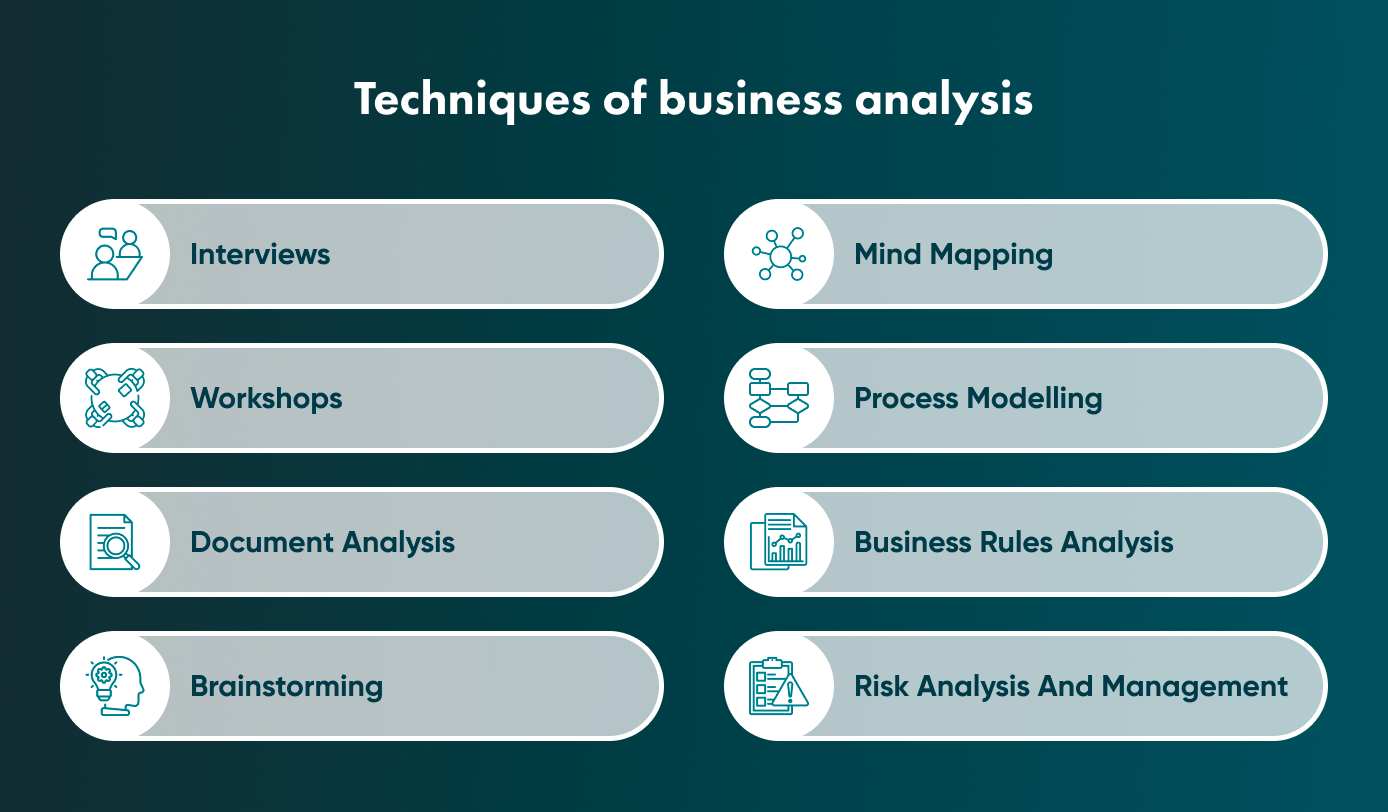Business Analysis in Software Development: What It Is, Its Benefits, and the Stages Involved


Software development entails risks and challenges, so it is essential to understand all practices that help prevent or mitigate these risks. The business analysis process is critical to identify all pitfalls in your future project and manage the development life cycle efficiently.
At Go Wombat, we pay careful attention to business analysis and risk management, so we always strive to provide a top-notch level of service. The article provides a definition of business analysis, its benefits, the steps of business analysis, and other useful nuances for those who want a comprehensive picture. We will explain how we do it at Go Wombat.
What business analysis is
Business analysis is the process of information collection using specific techniques to identify business requirements and submit required changes and solutions that improve and optimise the project development process. Simply put, the process of business analysis aims to find answers to issues that are yet to be solved.
In business analysis, we use critical conceptions and ideas to develop a source structure for any project. A set of tasks, skills, and methodologies needed to identify the business requirements – this is what business analysis is about.
Business analysts are specialists who conduct business analysis. They are in charge of risk analysis and management and perform data analyses to identify all requirements and generate appropriate reports. Analytical thinking and the ability to focus on every tiny detail are two main characteristics of business analysts. Professional analysts should analyse organisations by documenting all processes. Commercial risk analysis, business model assessment, vulnerability identification, and submission of appropriate solutions to achieve the set business objectives are the main tasks of a business analyst.
Why business analysis is vital in software development
Why can’t you ignore business analysis and skip this phase? Because it includes three critical steps.
Elicitation of product requirements
Business analysts gather the requirements for future software, and they collaborate with clients, business stakeholders, project managers, and developers to elicit all the required information that will be used for reliable software development. Thus, adequately collected requirements will help developers build the right product.
Needs identification
Understanding the future needs of end-users allows business analysts to consider all risk factors and prevent them. However, end-users are not only customers who will use the product. Stakeholders and investors are also deemed end-users waiting for your product. So business analysis contributes to identifying all end-users needs and expectations and meeting their vision.
Communication planning
Communication is the basis of everything. In fact, business analysts create a medium between developers and clients that helps them communicate better. Business analysts spend a lot of time communicating with all parties involved to build a proper approach and strategy. In the case of neglect of business analysis, if a software development company skips this stage, the result will be unpredictable, impacting the company’s reputation.
Need a full-cycle development from scratch? Go Wombat is at your service — tell us about your project.
Benefits of professional business analysis
This section clearly describes business analysis's advantages to a future product. You will see the main benefits of business analysis in software development.

Precise requirements elicitation
The business analysis's first and most significant advantage is eliciting detailed requirements for future software development. Business analysts collect functional and non-functional requirements. Functional requirements determine software functionality developers should integrate to allow end-users to perform their tasks within business requirements. In some documents, they are called behavioural requirements.
Non-functional requirements describe goals and quality attributes. Quality attributes explain characteristics of product features, like usability, integrity, efficiency, fault-tolerance, interaction, etc. So product requirements always include functional and non-functional business analysis requirements.
Better effort estimation
Another benefit of going with professionals is that it becomes much easier to estimate the effort spent on software development. Business analysts can assess how much effort is required to create a specific product considering all the requirements. Also, it makes it possible to draft budget and project plans in the early stages of the development life cycle.
Cost reduction
Although business analysis requires upfront costs, it contributes to the final cost reduction. The software development process is more complex than it seems. Developers will need the precise specification to avoid unexpected challenges and new requirements. Such challenges extend the development process and impact the cost accordingly. So business analysis will help you keep on budget and optimise the development process.
Predictable and quick development
Due to well thought out documentation, all development process participants know what they should do and what the result should be. The development will move faster, and it is unlikely that any unforeseen situation may arise.
The product meets expectations
Stakeholders get the product that meets their needs and expectations since all the requirements were elicited considering each business nuance of the future project. As a result, stakeholders get the product they paid for, and customers are satisfied with the software because they get the desired functionality.
Steps of business analysis
There are common stages of business analysis that companies usually do. These stages are also called knowledge areas. Go Wombat also adheres to this practice, so it is high time to discover more details about these areas.

Planning and monitoring
This step implies coordinating and organising stakeholders' and business analysts’ efforts. The knowledge area includes a range of tasks to be done by analysts.
Analysts build an approach to business analysis planning, choose methodology, and plan separate events. Also, a business analysis plan describes the procedure for interaction between stakeholders and analysts, current topics to discuss, and ways to improve communication.
The planning and monitoring stage helps ensure that all decisions are made properly and that decision makers have all the required information to keep working on the project.
Elicitation and collaboration
The elicitation and collaboration stage describes tasks business analysts perform to get the correct information from stakeholders and confirm the results.
In the course of requirements elicitation, the information is obtained from stakeholders or other sources. This is the primary way to elicit the requirements, including interviews with stakeholders and examining different local practices.
Discovery phase
We also start the discovery phase, a detailed analysis of a future product. First, we determine product characteristics and all potential business and technical requirements. The discovery phase is an important and time-consuming process that lasts during all business analysis stages. Therefore, it would benefit you to get deeper into this topic and read our article about the discovery phase.
Requirement life cycle management
During this phase, business analysts manage and maintain requirements and design information from inception to retirement. It is necessary to ensure all business requirements, stakeholders’ needs, and design will be consistent and aligned. A solution must implement these requirements.
It includes a level of control over requirements, how they will be implemented, and how they will be delivered to the client. This stage helps ensure that all business analysis information will remain available for clients in the future.
Strategy analysis
The strategy determines the most efficient way to apply the company’s potential to achieve the set goals. Strategies may exist for the entire company, department, product, or project.
Here analysts must interact with stakeholders to identify strategic or tactical impact requirements and create the software that will meet these requirements. The strategy analysis helps our business analyst department choose the best ways to promote the product and show its current value.
As a result, analysts can build a long-term competitive strategy after a detailed study of the market and the company itself, and analysts can make a long-term competitive strategy.
Solution evaluation
The final knowledge area and stage in business analysis is to evaluate all solutions, their effectiveness, and value. Analysts may recommend removing constraints or barriers that prevent the full implementation of a solution.
As a rule, developers and designers can already provide prototypes of future software to test it, obtain feedback from first focus groups, and take appropriate measures to improve the product according to the demands. This stage helps eliminate all the shortcomings in the early stage and avoid severe losses.
How much will your future software cost? Get a detailed estimate — contact Go Wombat.
Business analysis techniques
All steps in business analysis go along with the techniques analysts use to achieve the necessary result. There are more than 50 available techniques, but we will focus on those used by our analysts at Go Wombat.

Interviews
A crucial part of any analysis is communication with all the stakeholders to build a business analysis plan. Interviews help elicit important information, create an efficient strategy, and they are even carried out after the analysis to assess the efficiency of the business analysis.
Workshops
We hold meetings with stakeholders that help stakeholders get to know each other, build an analysis plan, identify possible solutions, manage changes, determine priorities, and elicit hidden challenges. Workshops are also used to assess business analysis performance and generate new ideas.
Document analysis
Our business analysis department spends a lot of time reviewing existing documentation to build a strategy analysis, productive collaboration, and elicit all the valuable data to do their job efficiently.
Brainstorming
Brainstorming is one of our analysts' core techniques to uncover helpful information for business analysis needs. It is good to generate multiple ideas or requirements for the future product. Stakeholders share all their thoughts, and many of these ideas are valuable for business analysis.
Mind mapping
Analysts create mind maps to identify and categorise the information to be managed. A mind map is a diagram that includes tasks, ideas, images, and other elements related to the main subject. Business analysts need mind maps to understand the project better and elicit detailed requirements.
Process modelling
We explore clients' business processes and determine the approach to business analysis. It is also a graphical model that is a basis for process analysis and shows how work is carried out.
Business rules analysis
There are two types of business rules: definitional and behavioural. Business rules analysis is performed to elicit, express, validate, refine, and organise the rules that form business behaviour and guide business decision-making.
Risk analysis and management
Another mandatory business analysis methodology is required to analyse and identify possible risks in future software development and elaborate on how to mitigate these risks. This technique is critical, so check out our article about risk management in software development to examine it in more detail.
All that said, the list of techniques is not limited only to those mentioned above. Analysts may use other techniques depending on the project and its characteristics.
Summing up
The business analysis process is versatile and complex. It is only possible to describe some of these tasks and opportunities in one article. However, we managed to cover the main principles of business analysis and explain what our business analysts do to make reliable software that meets your customers' needs.
Go Wombat provides full-cycle software development services from scratch, so we do everything from concept to delivery. Business analysis services are included, of course. Our main goal is to build software that will meet your needs and give your business an advantage.
Do you have any questions? Let us know — we are here to help!
Unlock Success with Premium Software Development
Contact us


FAQ
What is business analysis and what is an example?
Business analysis is a set of techniques and tasks that works like a connecting link between the development company and stakeholders. Business analysis helps analysts understand the company's structure, policy, and field of activity. It generates ideas to improve the business and achieve the set goals.
A good example is a functional and non-functional analysis. Functional analysis means analysing software functionality and identifying features in the software that will meet user needs.
A non-functional analysis is conducted to discover the software quality attributes and identify how valuable and user-friendly it is.
What does a business analyst do?
A business analyst performs many tasks, but the main ones are:
- Elicit the client’s requirements and understand the problem the client wants to solve.
- Build the solution concept together with a team or independently.
- Turn the idea into a technical task with specific requirements for the future product. This process requires the use of many methodologies (techniques).
- Detail each requirement in the form of a spec.
- Communicate and collaborate with all the stakeholders to achieve a great result.
What are some different types of business analysis?
Three types of business analysis are available — functional, process, and organisational.
A functional type of business analysis is used to study the current system to see how it works and analyse customer expectations.
Process business analysis refers to when analysts monitor how the process is executed by studying its steps and workflow.
An organisational analysis is targeted at analysing the corporate culture and how it meets customer needs and market conditions.
How can we help you ?





